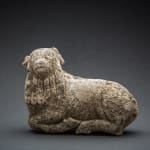Sumerian Sculpture of a Ram, 3000 BCE - 2000 BCE
Stone
14.6 x 10.2 cm
5 3/4 x 4 in
5 3/4 x 4 in
LO.1343
Further images
This figure presents a seated ram with all four legs folded back, balancing the body and head of the animal. The ram’s head is raised, presenting a stylised but lively...
This figure presents a seated ram with all four legs folded back, balancing the body and head of the animal. The ram’s head is raised, presenting a stylised but lively effect. The round eyes have an incised pupil and the eyebrows and forelock are formed of concentric loops. Two horns, identifying this sculpture, sweep back over small vertical ears, and long spiral curls hang down from under the jaw and onto the chest.
The Sumerian civilization was an extremely advanced and complex society situated in modern-day Iraq. Lasting for some four thousand years, the Sumerians were among the first cultures to develop most of what we now take for granted, from complex economies to advanced record keeping, literature, international trade and recorded mythologies. Thanks to the Sumerian habit of recording everything on clay tablets using cuneiform – one of the first complex writing systems – we can infer a great deal about their society. Boasting extensive trade networks, they were keen to form alliances and push out the boundaries of their nation into Central Asia and Turkey. In the centuries around 3300 BC, the world’s earliest states and cities emerged and with them some of the most accomplished representations of animals that have survived from the ancient world. Although movements of people reoriented long-distance trade routes around 3000 BC, Uruk and other cities of southern Mesopotamia (Sumer) continued to flourish and there was much continuity in their art. To the east, in Susa and across Iran, however, new ideas built on ancient highland traditions came to the fore and an emphasis on animals with elaborate horns emerged.
Rams or male goats were an everyday feature of life during this period and were regularly represented by sculptors in a variety of media. The exact meaning of the statue is not known but archaeologists believe the ram is one of several symbols associated with the fertility of the land. The goat was seen as sacred to Dumuzid, the shepherd god, whose marriage to Inanna was an important mythological event associated with agricultural abundance.
The Sumerian civilization was an extremely advanced and complex society situated in modern-day Iraq. Lasting for some four thousand years, the Sumerians were among the first cultures to develop most of what we now take for granted, from complex economies to advanced record keeping, literature, international trade and recorded mythologies. Thanks to the Sumerian habit of recording everything on clay tablets using cuneiform – one of the first complex writing systems – we can infer a great deal about their society. Boasting extensive trade networks, they were keen to form alliances and push out the boundaries of their nation into Central Asia and Turkey. In the centuries around 3300 BC, the world’s earliest states and cities emerged and with them some of the most accomplished representations of animals that have survived from the ancient world. Although movements of people reoriented long-distance trade routes around 3000 BC, Uruk and other cities of southern Mesopotamia (Sumer) continued to flourish and there was much continuity in their art. To the east, in Susa and across Iran, however, new ideas built on ancient highland traditions came to the fore and an emphasis on animals with elaborate horns emerged.
Rams or male goats were an everyday feature of life during this period and were regularly represented by sculptors in a variety of media. The exact meaning of the statue is not known but archaeologists believe the ram is one of several symbols associated with the fertility of the land. The goat was seen as sacred to Dumuzid, the shepherd god, whose marriage to Inanna was an important mythological event associated with agricultural abundance.





